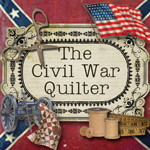Those who love antique quilt patterns owe much to the dedication of a few who meticulously and patiently seek out the names of old patterns or "first appearance" of old patterns by tracking obscure leads back-in-time.
 |
| Collection of Karen Alexander - won at AQSG Auction - previous owner Mary Bywater Cross |
 |
| True Lovers Knot? |
One such pattern created quite a stir in 2006 when a brief presentation was given at the annual AQSG Seminar. The pattern was already known in Kansas but the new lead showed a possible earlier date in the mid 1800s in Virginia among Quakers.
For those unfamiliar with this pattern, Mary Holton Robare has written at length about the version found near Winchester, Virginia. Read her research on the Virginia variation of this pattern by clicking here to reach The Quilt Index that carries her paper published in AQSG's Uncoverings in 2007.
You can also see a couple of samples of this pattern "Quilts of Virginia 1607-1899: The Birth of America Through the Eye of a Needle" [Schiffer Publishing, Atglen, PA. 2006 by Virginia Consortium of Quilters; ISBN0-7643-2465-9] on page 58-60.
The International Quilt Study Center has a version of this pattern which has been named "Snowflake". Go to the Collections' search page here and enter the collection # 1997.007.0263.1
To my friends on the facebook Quilts-Vintage & Antique discussion list....this is the center of the Four Block Red & Green applique quilt on page 82 of Ricky Clark's "Quilted Gardens: Floral Quilts of the Nineteenth Century" (Rutledge Hill Press/Nashville-1994-ISBN 1-55853-272-2) whose center resembles the Apple Pie Ridge Star/True Lovers Knot design. This quilt is dated 1850-1875 in the book.
Here is another variation but a much "fatter" version. This quilt is dated 1850ca. and is found on page 84 in the same book.
You can see this image as the center of still another quilt as well by clicking here. These are a matching pair of Princess Feather quilts sold at auction in 2010.
From the Woodward and Greenstein website:
Pair Antique Quilts: Princess Feather Applique
America. Ohio.1875
Pair of exceptional, large, finely stitched and quilted spreads in traditional pattern. Each quilt has slightly different configurations in design. Possibly made for the dowries of the maker's two daughters.
Price
$12,500
$12,500
Condition*
Excellent
Excellent
Measurements
height: 7 ft. 3 in. (221 cm)
width/length: 7 ft. 3 in. (221 cm)
height: 7 ft. 3 in. (221 cm)
width/length: 7 ft. 3 in. (221 cm)
Specifications
Number of items: 2
Materials/Techniques: Cotton, hand-quilted
Creator: unknown
Number of items: 2
Materials/Techniques: Cotton, hand-quilted
Creator: unknown
Photography
provided by 1stdibs
provided by 1stdibs
Location
Woodard and Greenstein
506 E 74th Street
5th Floor
New York, NY, 10021
Phone: 212-988-2906
E-Mail: info@woodardandgreenstein.com
Ref. : 0902058422130
Here is another version. According to Barbara Brackman's Encyclopedia of Applique (page 127) this pattern has appeared as "True Lovers Knot" (1912 in the Omaha World Herald); "Conventional Scroll" (in the Nancy Cabot pattern column in the Chicago Tribune - 20th c.) and "A Kansas Pattern" by Whitehill in the Denver Art Museum.
Brackman also noted that a variation of this pattern was seen (but unnamed) in an Album quilt dated 1847.
Below is a series of applique and pieced blocks that were sold on eBay in 2007. An example of this rather fleur-de-lis inspired pattern was included in the lot.
Below are more close-ups of the quilt in my collection of this pattern.
Woodard and Greenstein
506 E 74th Street
5th Floor
New York, NY, 10021
Phone: 212-988-2906
E-Mail: info@woodardandgreenstein.com
Ref. : 0902058422130
Here is another version. According to Barbara Brackman's Encyclopedia of Applique (page 127) this pattern has appeared as "True Lovers Knot" (1912 in the Omaha World Herald); "Conventional Scroll" (in the Nancy Cabot pattern column in the Chicago Tribune - 20th c.) and "A Kansas Pattern" by Whitehill in the Denver Art Museum.
Brackman also noted that a variation of this pattern was seen (but unnamed) in an Album quilt dated 1847.
Below is a series of applique and pieced blocks that were sold on eBay in 2007. An example of this rather fleur-de-lis inspired pattern was included in the lot.
Below are more close-ups of the quilt in my collection of this pattern.
























































